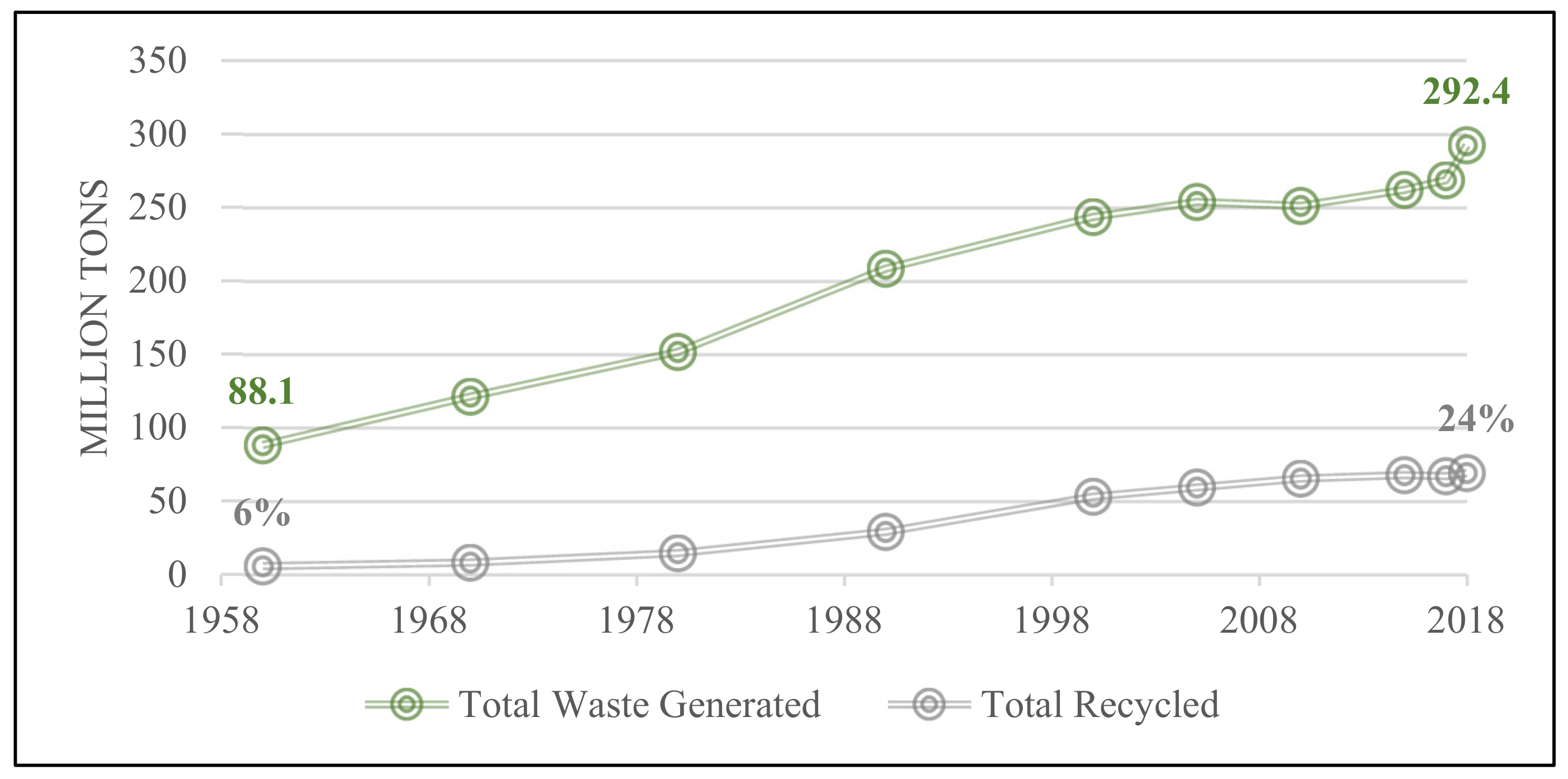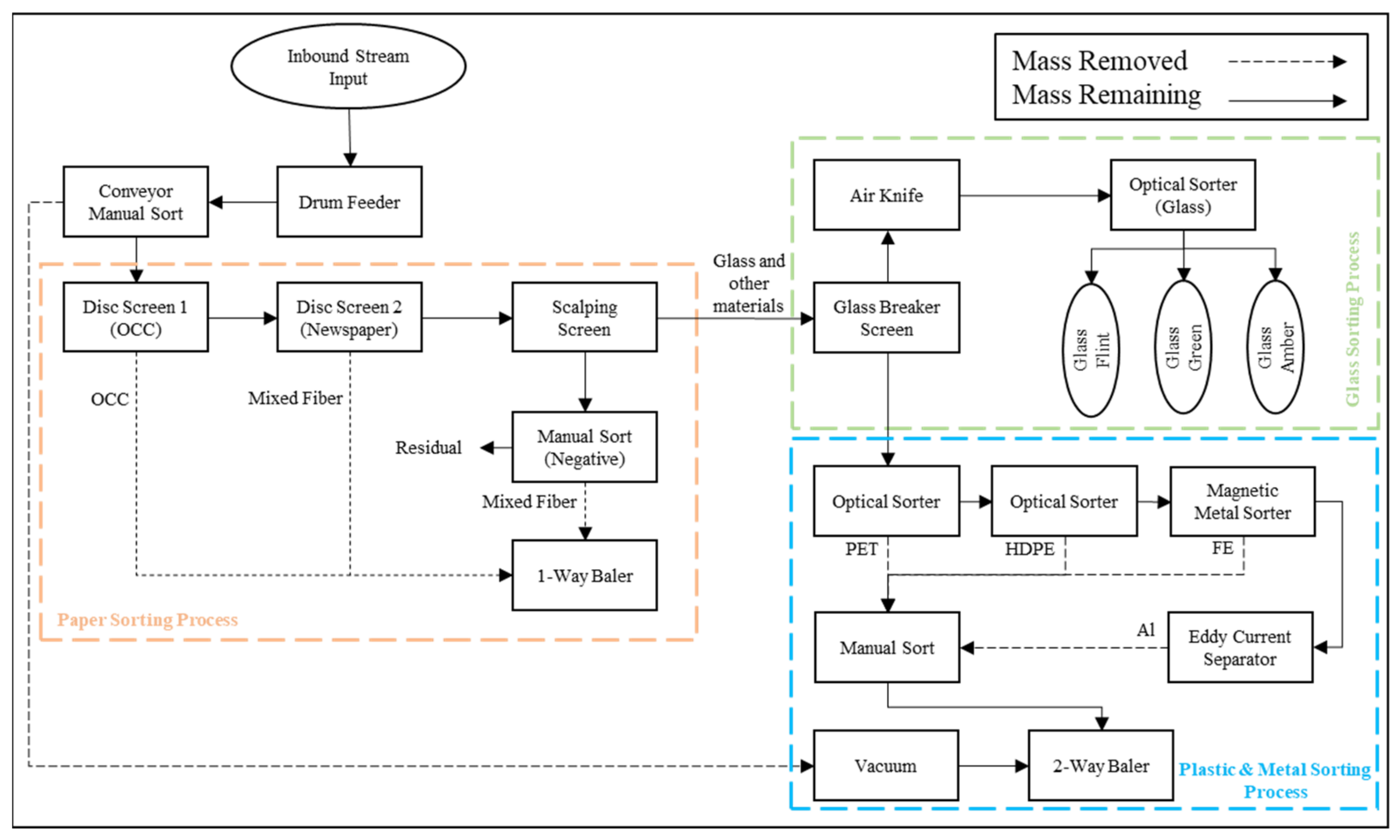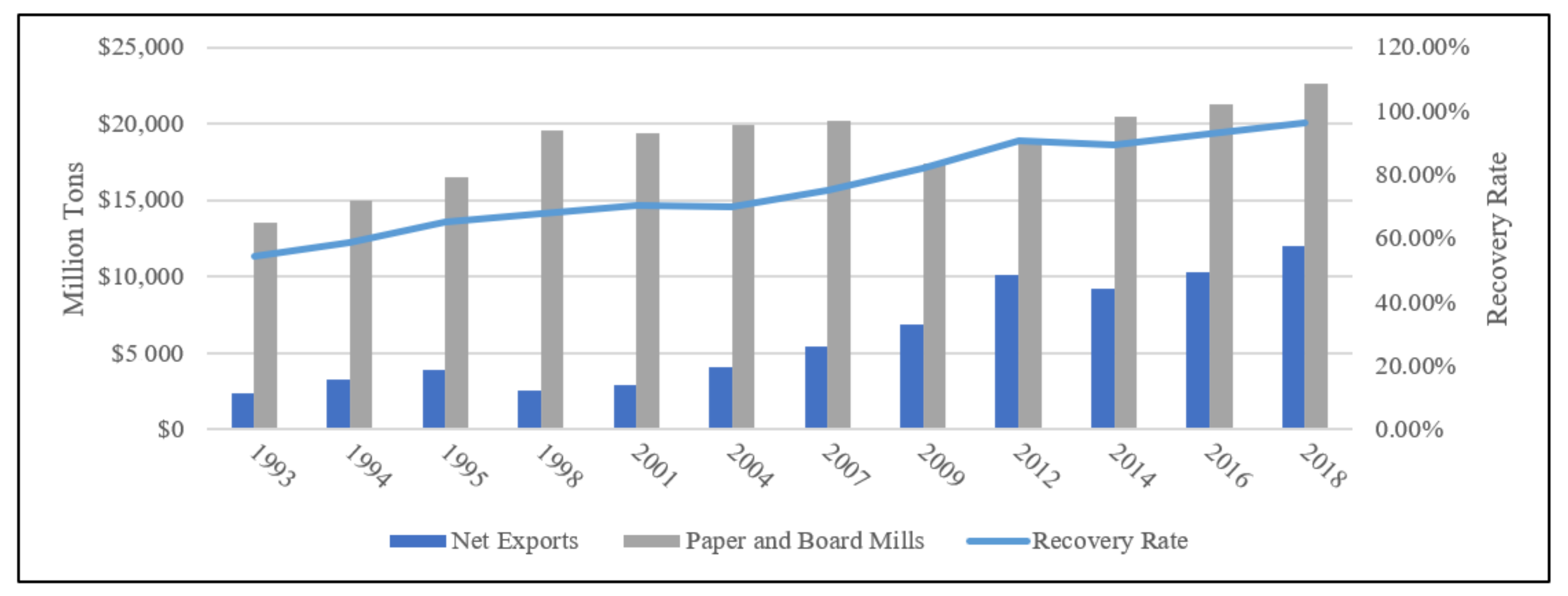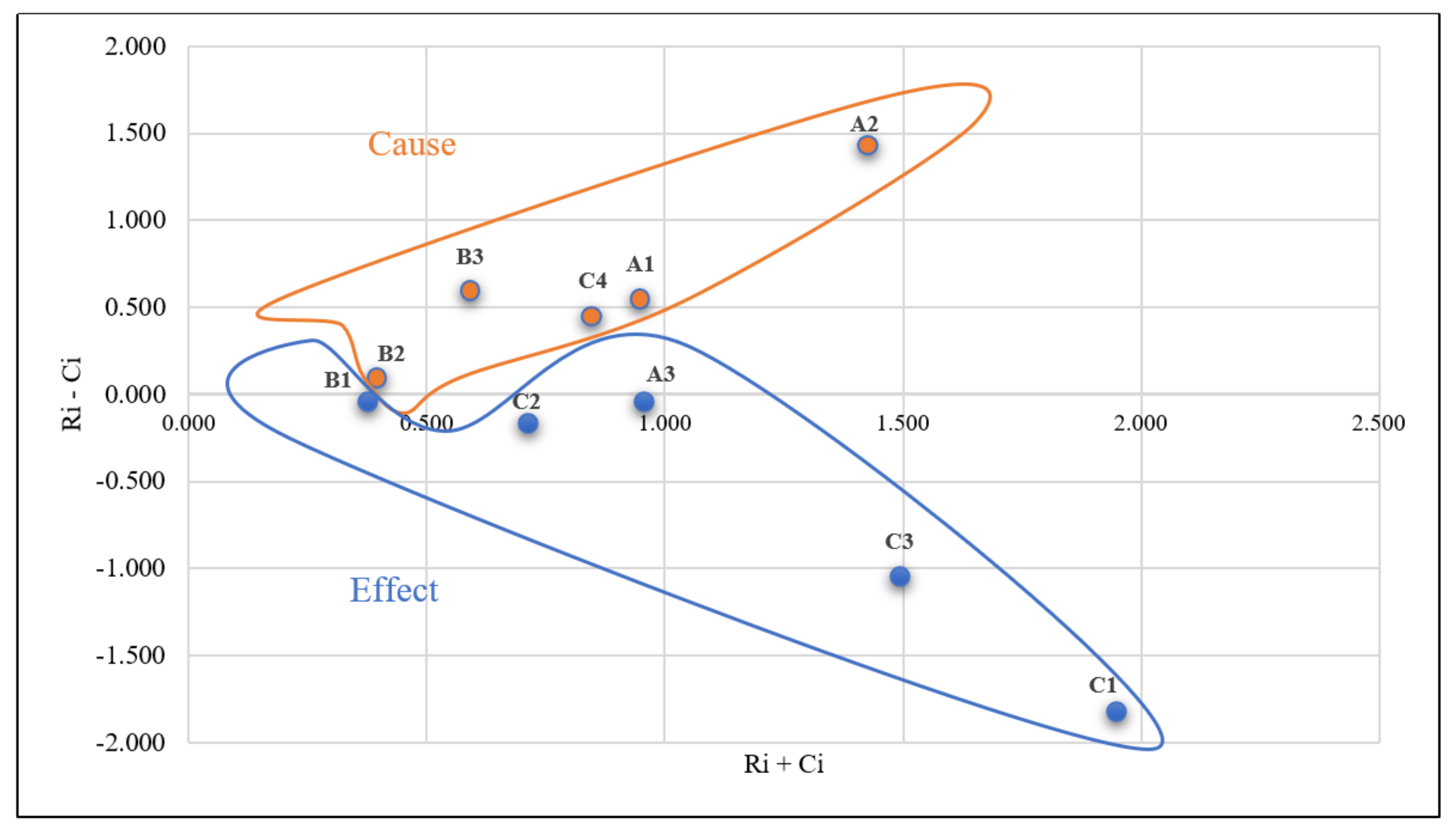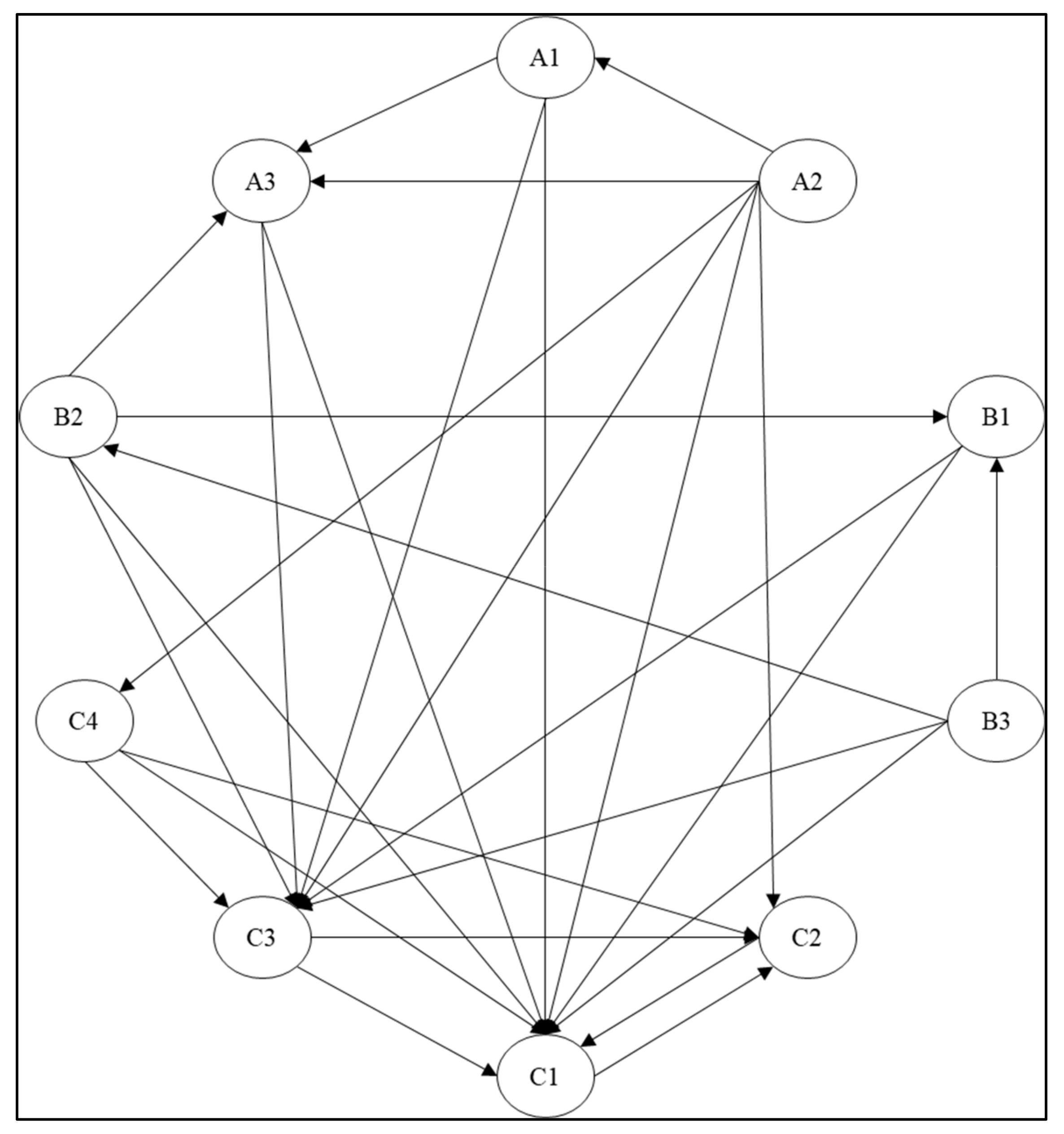1. Introduction
Solid Waste Management (SWM) is an integral component of modern communities’ environmental efforts to capture value from waste that would otherwise go directly to landfills and incinerators. Even though politically popular, and highly touted, waste management remains problematic due to expenses related to complex recycling processes and limited consumer participation [
1]. In more economically developed countries seeking a robust recycling economy, waste management represents a paradigm shift where municipalities hope to recapture value from waste streams [
1]. Thus, the process of recycling prevents the disposal of potentially valuable materials that would otherwise end up in a landfill or be disposed of inappropriately or at a high cost [
2]. In theory, sustainable development is achievable through the effective and efficient management of solid wastes. However, much more must be accomplished to improve public adoption and decrease the costly processes required to produce viable raw materials from the waste streams.
Bafail and Abdulaal [
3] define solid waste as “all neglected solid materials from municipal, industrial, and agricultural activities”. The traditional strategies for eliminating waste include landfills, composting, and incineration [
4,
5,
6,
7].
The increasing volume of waste is a global problem [
7,
8]. In 2018, the United States disposed of 146 million tons of Municipal Solid Waste (MSW) in landfills. However, identifying acceptable landfill space and the need to capture value from waste streams requires strategic rethinking [
9]. In response to growing awareness and concern, policymakers are advocating more stringent methods to reduce, reuse, and recycle to eliminate or dramatically reduce waste.
In response to greater public awareness and a 73% increase in MSW over the past 20 years, recycling is a highly visible municipal service in most communities in the United States [
10]. Community-level recycling efforts in the United States began in the 1970s; by 1985, Americans recycled more than 10% of available recyclable materials. However, participation varies widely, with some American cities recycling only 1% of recyclable materials [
11], highlighting the need for rethinking to make efficient and effective recycling programs available. In 2018, the United States was able to recycle 24% of the total waste generated (see
Figure 1).
Figure 1.
Total MSW produced and recycled in the U.S., 1960–2018 [
12].
Figure 1.
Total MSW produced and recycled in the U.S., 1960–2018 [
12].
In recycling collection programs in the United States, materials are generally shipped to a Material Recovery Facility (MRF), where recyclables are separated, processed, and stored for eventual sale as raw materials to mills and other end markets. The recycling collection methods deployed to collect waste for MRFs include Single-Stream Recycling (SSR), Dual-Stream Recycling (DSR), Multi-Stream Recycling (MSR), and Mixed Waste Recycling (MWR) [
3,
13]. SSR requires that consumers place recyclable plastics, metals, paper, and glass into a single bin for collection by waste management companies [
10]. DSR requires consumers to place paper recyclables in one bin and plastics, glass, and metal waste in another [
5,
14,
15]. The MSR method uses a separate bin for paper, plastic, glass, and metal recyclables. The MWR method requires waste generators to extract recyclables after collecting garbage [
3]. The primary purpose of all recycling methods is to recapture value from waste streams; their methods differ in collecting, processing, and sorting waste.
SSR is the most popular, and fastest-growing municipal recycling method in the United States. The program is attractive because consumers are not required to sort materials into bins. According to Moore [
16], the number of SSR MRFs increased in Florida from 5 facilities in 1995 to 287 in 2014. Moreover, in 2005, 22% of the U.S. population with recycling programs had access to SSR programs. This percentage grew to 73% in 2014 [
17].
As illustrated in
Figure 2, once collected, the SSR method typically involves front-end loaders on the MRF tipping floor to push the contents of the collection trucks to a drum finder. The drum distributes the materials to the first conveyor belt for personnel to remove large or potentially unacceptable items from reaching downstream equipment. In addition, plastic film is vacuumed away and sent to a two-way baler. The cardboard is subsequently recovered and diverted to a one-way baler. The separation process then recovers newsprint and removes potential contaminants. Glass waste is broken into cullet before an air knife removes glass materials. Ceramics and similar materials, not easily recyclable, are discarded. Optical sorters then examine the remaining waste stream to identify the most recycled types of plastic in the U.S., polyethylene terephthalate (PET) and high-density polyethylene (HDPE). Finally, a magnet scans the waste for ferrous recovery, and an eddy current separator identifies aluminum for recovery.
Figure 2.
Materials flow in SSR at MRFs [
18].
Figure 2.
Materials flow in SSR at MRFs [
18].
The commingling of recyclable materials inherent under the SSR model poses a high risk of contaminating solid waste streams by complicating the separating, sorting, and recovering materials in MRFs. Contamination in SSR refers to prohibited items that have been sorted into a SSR recycling bin. For instance, food waste, yard waste, batteries, Styrofoam, garbage, shredded paper, liquids, film plastics, plastic bags, clothes, electronics, compact disc (CDs) and video home system (VHS) tapes are all examples of prohibited items in SSR inbound stream. On the other hand,
Table 1 shows some examples of accepted items in SSR.
The SSR method results in increased recycling costs leading to reduced revenues for the MRFs [
19,
20]. Moreover, high contamination of inbound streams results in prohibitive contamination rates in materials that are shipped to mills. In paper mills, if the prohibitive contamination rate exceeds the paper mill prohibitive standard rates, the outbound paper materials become useless [
21]. High contamination levels in the waste stream also increase the incidence of recycling equipment machine failure [
10]. According to Moore [
16], contamination rates using SSR can be as high as 50% of the inbound stream, with an average contamination cost of USD 125 per ton (per 2000 lb). Waste Management [
22] estimates that 25% of items placed in recycling are not recyclable due to their composition, grades, or contamination [
23].
MRFs strive to reduce the volume of contaminants in inbound streams to harness as much of the value of recyclables as possible. One of the most important ways MRFs attempt to reduce SSR collected waste is by knowing and identifying the causes of contamination. Therefore, this paper aims to deploy the robust, scientific Decision-Making Trial and Evaluation Laboratory (DEMATEL) technique to demonstrate the effectiveness of identifying causes of contamination in the inbound stream from SSR programs arriving at MRFs. DEMATEL is a Multi-Criteria Decision-Making (MCDM) tool that is considered to be an adequate method for the identification of cause–effect chain elements in complex systems. Moreover, MRFs rely heavily on robust scientific cause-and-effect analysis within MCDM frameworks to address the issue [
24]. MCDM permits decision makers to evaluate potential alternatives by simultaneously applying multiple conflicting criteria [
25]. The capability of handling different criteria makes MCDM methods effective, often resulting in efficient decision-making to solve complex problems [
26].
In addition, there is a lack of discussion of the causes of inbound and outbound forms of contamination in the recycling collection programs in the literature. Therefore, this paper seeks to contribute by covering some of the gaps in the literature. It will do this by using a robust scientific MCDM method to identify the causes of inbound contamination in SSR which will assist decision makers at MRFs in taking corrective actions to reduce the contamination rate in other recycling collection programs.
The balance of this paper addresses the following topics in turn.
Section 2 provides additional background relating to the contamination problem.
Section 3 reviews studies of existing inbound waste stream contamination and efforts to deploy techniques/methods to ameliorate the problem.
Section 4 describes the DEMATEL procedure step by step.
Section 5 provides a discussion of the detailed analysis undertaken by this study. The final section presents the study’s conclusions.
2. Background of Inbound Contamination Rate in SSR Programs
Until 2017, the United States shipped most of its recyclable materials to China for processing. Due to its flexible regulatory environment and low labor costs, China was a leading global processor of recycled materials. In February 2017, China announced its “National Sword Policy”, introducing a goal to reduce the importation of contaminated recyclable materials. In April 2017, China prohibited future “solid waste materials for import” and canceled the renewal of solid waste import licenses the following month. In July 2017, China informed the World Trade Organization (WTO) that it would “forbid the import of 24 types of solid waste and recyclables and require reduced contamination rates for other materials to 0.3%” [
27,
28]. The policy expanded and strengthened 2007 restrictions on such contaminants [
29] and China’s 2013 Green Fence initiative, which implemented random inspection of such imported recyclable materials as plastics and recovered paper materials [
29]. Imported recyclable materials of increasingly poor quality and containing high levels of contaminants triggered the policy changes [
27]. Collectively, these changes drove up Chinese prices for recycling; by September 2017, mixed fiber recyclable material bale prices in the United States fell dramatically from average prices in July 2017 of USD 65 in the Northwest, USD 70 in the Northeast, USD 72 in the Southeast, USD 72 in the Southcentral, and USD 70 in the Southwest to average prices of USD 17, USD 32, USD 37, USD 32, and USD 30, respectively (see
Figure 3,
Figure 4 and
Figure 5). Moreover, the average prices of mixed-fiber recyclables continued to decline to zero in all regions in the United States by September 2019. On the other hand, the average prices of OCC bales were traded between USD 106 and USD 110 in all regions in the United States in November 2016. The average prices of OCC bales increased to over USD 150 in all regions in July 2017 before they fell dramatically in May 2019 to average prices of USD 15, USD 37, USD 37.5, USD 37, and USD 20 in the Northwest, Northeast, Southeast, South Central, and Southwest, respectively. United States municipalities faced the prospect of either absorbing the increased recycling and sorting costs or shutting down recycling programs. To address these sudden changes, some municipalities resorted to stockpiling or incinerating their waste [
30]. These changes also spurred interest in the development of new recycling approaches.
Figure 3.
Average regional prices of mixed paper bales from November 2016 to January 2020 in Northwest, Northeast, Southeast, Southcentral, and Southwest regions in the United States [
31].
Figure 3.
Average regional prices of mixed paper bales from November 2016 to January 2020 in Northwest, Northeast, Southeast, Southcentral, and Southwest regions in the United States [
31].
Figure 4.
Average prices of recovered OCC bales from November 2016 to January 2020 in Northwest, Northeast, Southeast, Southcentral, and Southwest regions in the United States [
31].
Figure 4.
Average prices of recovered OCC bales from November 2016 to January 2020 in Northwest, Northeast, Southeast, Southcentral, and Southwest regions in the United States [
31].
Figure 5.
Recyclables market regions in the United States [
31].
Figure 5.
Recyclables market regions in the United States [
31].
China’s new regulatory stance continued to permit the import of OCC as long as the contamination rate was less than 0.5%. Even though the quantity of OCC exported to China increased steadily (see
Figure 6), the average price of OCC in the United States, like that of recovered mixed paper overall, has fallen since September 2017 (see
Figure 4), regardless of the curbside collection program. The price reduction is likely attributable to revenue losses from recyclables no longer exported to China.
Figure 6.
Total net exports (per million tons) and recovery rate of Old Corrugated Cardboard in the United States [
17].
Figure 6.
Total net exports (per million tons) and recovery rate of Old Corrugated Cardboard in the United States [
17].
The complexities and costs inherent in the single, dual, or multi-stream recycling schemes are critical to understanding the present recycling dilemma. For example, in contrast to the minimum required consumer involvement with an SSR-based program, consumers participating in a DSR program must separate fiber, paper, and cardboard materials from glass, plastic, and metal before collection. DSR was the early standard recycling program in the United States [
32]. However, numerous studies projected widespread consumer acceptance of recycling if consumers were relieved of having to identify and sort their waste as promised by SSR. Widespread adoption of SSR shifted the primary means of recyclable collection away from DSR [
32].
While SSR adoption increased consumer participation in recycling efforts, some municipalities in the United States continued to use DSR, finding that the poor quality of the collected materials under the SSR approach rendered recycling no longer cost-effective [
33,
34,
35]. For example, the high cost of advanced and intensive screening techniques, particularly in the case of plastics [
35,
36], is a considerable disadvantage compared to optimal MSR recycling programs [
35,
37,
38].
While the general population more readily accepts SSR, scarcely any research directly compares the inbound and outbound material quality and contamination levels of DSR, MSR, and SSR collected materials. Thus, one cannot definitively state that poor-quality recyclables are specific to SSR programs. Regardless, the reported causes of inbound contamination in SSR require identification to take corrective action to reduce the contamination in SSR programs.
3. Literature Review
The noted lack of research comparing contamination problems among various recycling collection methods is, for all practical purposes, a secondary concern in light of overwhelming public preference and an enhanced level of participation noted by numerous researchers. Bell et al. [
39] advocated using SSR in Wisconsin because of its positive effect on households adopting recycling as a waste disposal method. Damgacioglu et al. [
21] supported Bell et al.’s [
39] findings and indicated that SSR is the preferred recycling program because of reduced collection costs and increased collection volume. Yasar et al. [
40] also supported the use of SSR because of increased participation, reduced collection costs, reduced household sorting efforts, and fewer required waste-collection vehicles [
41,
42,
43]. Thus, despite potential disadvantages of SSR, such as increased processing costs and risks of higher contamination rates [
3,
18,
21,
43,
44], the demonstrated benefits are encouraging many waste management companies and municipalities to implement the method.
Even though there are few comprehensive evaluations of collection methods, numerous studies have examined differences in collection methods by recycled material type. Tonjes et al. [
41] reported that SSR collected a greater volume of paper (over 25,000 tons) than DSR from 2004 to 2016. Although trends in Tonjes et al.’s [
41] study suggests efficiencies in collecting paper with SSR, there was an overall reduction in recyclable material compared to DSR.
Farrel [
45] noted that fine-glass shards form during automated SSR collection. These small shards pose a significant challenge to SSR processing operations when they become lodged in paper, making the paper unrecyclable and increasing MRF costs [
10,
46].
According to Yedinak [
47], as a result of China’s National Sword policy, the U.S.’s SSR has been revealed to have many drawbacks, increasing doubt about whether it can be sustained long-term. In order to make recycling more efficient, policies that reduce contamination levels in the recycling stream and facilitate recycling must be implemented. Across the U.S., some municipalities have begun switching from SSR to dual-stream recycling in order to curb contamination levels [
48,
49,
50,
51,
52]. It has been reported in Yedlink’s [
47] paper, the switch to SSR adversely impacts the quality of recycled glass. Therefore, Yedlink reported that the breakage of glass during the collection stage in SSR reduces its recovery or allows other materials and different-colored glass to contaminate it. Thus, on average, only 40% of glass can be recycled from an SSR system, compared with 90% in a multi-stream recycling system [
47]. Additionally, glass is frequently cited as a contamination issue for other recycled materials, such as paper and plastic [
47]. In a comparative analysis reported in Bashir et al. [
53], excluding glass materials from SSR program can reduce the contamination level rate in SSR by 3.61%.
Mixing certain plastic materials such as HDPE, HDPE colored, PET, and film with other recyclables at the collection stage can cause contamination to the MRF inbound stream [
44]. Rosbach [
54] asserts that the U.S. currently recycles only 10% of its annual plastic waste, which is an alarming statistic. Rosbach applied a range of qualitative and quantitative techniques, which includes conducting interviews, analyzing documents, and surveying data, to identify a lack of proper education regarding recycling as the most significant factor contributing to low recycling rates in SSR [
54]. Hence, raising participant awareness regarding separating recyclable and non-recyclable plastics is critical to reducing contamination rates [
55]. In developing countries, end-user behavior is a critical factor in recycling program participation [
56]; generally, raising consumer awareness increases the recovery rate of outbound recyclables.
Contaminants from plastics reduce the number of acceptable grades for recycling since they can damage the recycling equipment [
40]. Furthermore, limiting the number of plastic grades can reduce the recovery rate since non-recyclables form a significant volume of materials in the SSR inbound stream [
18,
57]. Moreover, consumer placement of all plastics in a single bin complicates sorting into categories at MRFs [
39].
Bashir et al. [
53] conducted a comprehensive case study analysis to delineate the factors associated with decreasing the efficiency of the SSR. The researchers conclude that improving MRF performance requires extensive education and awareness programs at the communal level. A lack of education leads to an increase in unrecyclable materials in the single bin system.
Quality of materials sorted, manual versus automated sorting techniques, and residue and contamination levels are all critical factors that affect MRF production in SSR. Manual sorting of recyclables involves workers handling the waste by identifying and inspecting it visually [
53]. In 2018, the Monterey Regional Waste Management District reported that although the MRF was designed to a handle single-stream recycling program and a mixed-waste recycling program with a high-quality section implemented on OCC and all plastics, it was not confident about reaching the 0.5% contamination rate set by China [
53]. A Metro Waste Authority study concluded that current SSR equipment cannot meet the 5% contamination standard [
53].
All of the earlier studies examined for this paper reported contamination in all recycling collection programs. However, no study reported using MCDM to help determine the cause and effect of contamination in SSR program by evaluating inbound or outbound contamination rates.
Researchers have used MCDM techniques to conclude that a decision support framework is best when it comes to assisting waste management companies in determining which SWM strategies they should implement. Despite the severe lack of previous studies that did not use MCDM in SSR programs, there are many scholars who have used MCDM in various problems within the scope of waste management.
Coban et al. [
58] utilized the Technique for Order of Preference by Similarity to Ideal Solution (TOPSIS), Preference Ranking Organization Method for Enrichment Evaluation (PROMETHEE) 1, and PROMETHEE II to determine the most appropriate and sensible scenarios for municipal waste management in Istanbul. Despite using multiple methodologies, the researchers selected the same scenario to implement in Istanbul. Thus, MCDM techniques can provide a reliable framework for determining the best alternatives to handling solid waste management.
Other scholars conducted similar studies using MCDM methods. Arıkan et al. [
59] also evaluated the most effective waste-disposal strategies for Istanbul using the TOPSIS, PROMETHEE, and Fuzzy TOPSIS decision support frameworks. Although their study was similar to that of Coban et al. [
58], the results differed. Qazi et al. [
60] also undertook studies using MCDM methods to determine the most effective technologies for MSW in Oman. Their findings were similar to those of Arıkan et al. [
59], finding that anaerobic digestion followed by burning was an effective waste disposal technique to reduce the volume of waste, limit greenhouse gas emissions, and stabilize landfill costs.
Shahnazari et al. [
61] identified an optimal thermochemical technology in MSW management using the Analytic Hierarchy Process (AHP) and TOPSIS MCDM models. The results of both MCDM models identified plasma as the optimal thermochemical technology in SWM, again demonstrating that MCDM methods are effective decision-making tools in SWM selection.
Alkaradaghi et al. [
62] used the AHP MCDM methodology in collaboration with a Geographic Information System (GIS) to select an optimal landfill site in Iraq. Sisay et al. [
63] used similar methods to Alkaradaghi et al. [
62] in selecting a suitable landfill site for the town of Gondar in Ethiopia. Van Thanh [
64] used the Fuzzy AHP technique combined with the Combined Compromise Solution (CcCoSo) model to find a suitable location for a solid-waste-to-energy plant. MCDM methods clearly can be successfully used to make decisions on appropriate site locations for solid waste management landfills and plants.
One area in which additional research is required is how community characteristics influence the effectiveness of different recycling programs, allowing communities to optimize their recycling programs to fit their specific needs [
41]. Moreover, while the literature addressing inbound SSR contamination is sparse, no study has utilized a rigorous cause-and-effect analysis using techniques offered by DEMATEL to address that gap in the literature.
4. Materials and Methods
Within MCDM, DEMATEL provides a systematic structural modeling approach to analyzing cause-and-effect relationships of system components. The Geneva Battelle Memorial Institute of Science developed the approach between 1972 and 1979 [
65,
66]. Constructing an influence map is the most distinctive feature of DEMATEL. The first step in map-building requires defining an evaluation hierarchy and selecting the expert team. One must then calculate the relationship matrix and determine the appropriate degrees of influence. Creating the total relationship influence map requires R + C and R − C calculations. R represents the sums of rows, while C represents the sums of columns. Casual diagrams can be obtained by mapping the datasets of (R + C, R − C), where the horizontal axis (R + C) referred to as “Prominence” is created by adding R to C, while the vertical axis (R − C) referred to as “Relation” is created by subtracting C from R [
67,
68]. Furthermore, (Ri + Ci) provides a measure of how much influence the factor has exerted and received. Thus, (Ri + Ci) illustrates how important factor i is to the problem. On the other hand, it indicates that factor i influences other factors if (Ri-Ci) is positive, whereas if (Ri-Ci) is negative, other factors are influencing factor i. A typical approach to constructing a DEMATEL tool is as follows [
69]:
- Step #1:
An expert panel and dimensions/criteria are determined. This step involves gathering subjective opinions from a panel of experts. The challenges are determined and discussed based on the literature and expert opinions.
- Step #2:
Construct a direct-relation matrix generated by making pairwise comparisons between the criteria involved. Rate the level of relationship between the criteria using the scale shown in
Table 2.
represents expert
k, which perceives criteria
i as exerting influence on criteria
j. Assume M experts and n criteria result in M non-negative matrices of nXn dimension. In the case where
i =
j, the value is 0, which indicates no influence. The following formula develops the average matrix A:
- Step #3:
An initial normalized direct matrix D is created by Equation (2):
The value of each element in matrix D is between 0 and 1.
- Step #4:
Total relation matrix T is
where
I is the identity matrix.
- Step #5:
“Prominence”, which is represented by + and “Relation”, which is represented by − are computed for each criterion.
- Step #6:
Map the dataset ( + ; − by using the cause-and-effect diagram.
For the problem under examination, each factor’s importance is prioritized based on its relationships, including degrees of dependence or interdependence. DEMATEL sorts the critical factors into cause–effect groups and illustrates the relationships through impact relationship diagrams. Drawing upon earlier studies’ reported critical factors or criteria related to SSR programs’ inbound contamination rates, this examination classified those major criteria along three dimensions, as shown in
Table 3. The criteria hierarchy for the problem under examination is illustrated in
Figure 7.
The evaluation matrix, which represents the experts’ opinions, is presented in
Table 4. Invitations were sent to experts to participate in this study. Experts were selected based on the qualifications and experience in solid waste management, especially in MRFs that utilize SSR programs in the United States.
Table 5,
Table 6 and
Table 7 show the DEMATEL calculations necessary to obtain R + C and R − C values.
6. Conclusions
In complex, real-life problems, identifying cause-and-effect relationships helps to better understand both the events that occur and the reasons why they occur in a system. The complexity of recycling processes and the limited participation of consumers make waste management a challenging issue despite its political popularity and the high praise that it has received.
This paper utilizes a robust and scientific technique, DEMATEL, to identify contamination causes in the inbound stream from SSR programs arriving at MRFs. This paper concludes that the SSR automated sorting process has the highest prominence in causing problems, with a prominence value (R + C) of 1.949. The lack of education and recycling awareness campaigns is second, with a prominence value (R + C) of 1.428. Moreover, the findings show that insufficient public awareness, insufficient municipal and waste collection companies’ awareness, the shape and condition of SSR containers, weather conditions, and insufficient training of workers at MRFs are causal factors, while consumer resistance to participation, configuration and maintenance of recycling vehicles, the SSR automated sorting process, types and conditions of machine separation at MRFs, and manual sorting processes at MRFs are affected factors.
It is not surprising that this study found the primary reason for contamination of inbound SSR waste to be the inefficiency of automated MRF sorting equipment. Consensus exists that material sorting in SSR is inefficient, given that SSR recycling transfers the work of sorting from individual consumers to MRFs. As a result, this study recommends upgrading the sorting equipment at SSR MRFs. As this study also found that a lack of awareness of how SSR programs operate increases the inbound contamination rate, it recommends that decision makers at SRR MRFs prepare appropriate campaigns to increase consumer and employee awareness and knowledge about SSR programs and the importance of separating recyclable and non-recyclable materials.
It is important that scholars continue to discover more causes of high contamination in SSR inbound streams. Additional investigation into the weights of each criterion’s influence on contamination may possibly assist in designing the best possible educational practice programs.
This paper suggests that future studies use an MCDM technique such as AHP, Ranking Alternatives by Perimeter Similarity (RAPS), Multiple Criteria Ranking by Alternative Trace (MCRT), VlseKriterijuska Optimizacija I Komoromisno Resenje (VIKOR), or TOPSIS to rank alternative educational methods to help choose the most effective means of achieving greater awareness for consumers and employees. Moreover, it is crucial to discover the accepted materials in SSR programs that cannot be recycled due to either the nature or the size of the material. For example, while all types of glass are prone to breakage when loaded onto collection trucks, during transportation and unloading into MRF and processing, broken pieces further contaminate plastic and paper materials. Therefore, studying the exclusion of glass materials from the SSR collection process or upgrading the screening equipment in MRFs will help decision makers in reducing SSR inbound contamination level.
